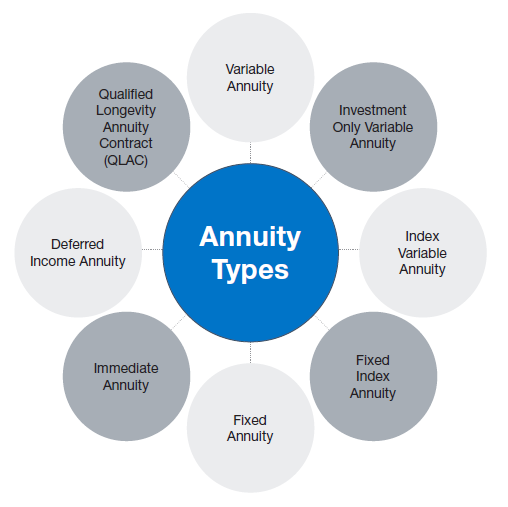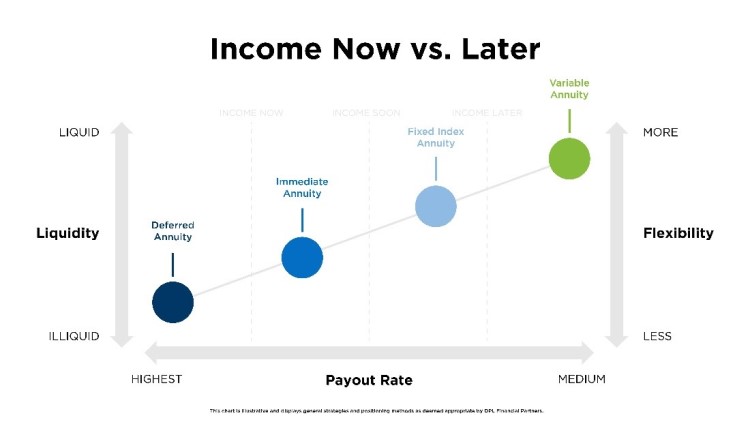All Categories
Featured
Table of Contents
The settlement may be invested for development for an extended period of timea single premium delayed annuityor invested for a brief time, after which payment beginsa solitary costs immediate annuity. Single premium annuities are often funded by rollovers or from the sale of a valued asset. A flexible costs annuity is an annuity that is meant to be funded by a series of payments.
Proprietors of repaired annuities know at the time of their purchase what the worth of the future capital will be that are produced by the annuity. Clearly, the number of capital can not be recognized ahead of time (as this relies on the contract owner's life expectancy), but the assured, repaired passion rate at the very least gives the proprietor some degree of assurance of future earnings from the annuity.
While this difference seems straightforward and uncomplicated, it can substantially influence the value that an agreement proprietor inevitably stems from his or her annuity, and it develops substantial uncertainty for the contract owner - Variable annuity features. It additionally typically has a product influence on the degree of fees that an agreement owner pays to the issuing insurer
Fixed annuities are commonly utilized by older investors who have restricted possessions but that desire to balance out the danger of outliving their possessions. Fixed annuities can work as an effective device for this purpose, though not without certain disadvantages. For instance, when it comes to immediate annuities, once an agreement has actually been bought, the contract owner relinquishes any and all control over the annuity properties.
Exploring the Basics of Retirement Options A Comprehensive Guide to Investment Choices Breaking Down the Basics of Fixed Indexed Annuity Vs Market-variable Annuity Benefits of Annuities Variable Vs Fixed Why Variable Annuity Vs Fixed Annuity Is a Smart Choice How to Compare Different Investment Plans: A Complete Overview Key Differences Between Different Financial Strategies Understanding the Rewards of Fixed Vs Variable Annuities Who Should Consider Strategic Financial Planning? Tips for Choosing Annuity Fixed Vs Variable FAQs About Deferred Annuity Vs Variable Annuity Common Mistakes to Avoid When Choosing Indexed Annuity Vs Fixed Annuity Financial Planning Simplified: Understanding Choosing Between Fixed Annuity And Variable Annuity A Beginner’s Guide to Smart Investment Decisions A Closer Look at Choosing Between Fixed Annuity And Variable Annuity
For instance, an agreement with a normal 10-year surrender duration would bill a 10% abandonment fee if the agreement was surrendered in the very first year, a 9% abandonment fee in the second year, and more until the abandonment fee reaches 0% in the agreement's 11th year. Some postponed annuity agreements include language that enables tiny withdrawals to be made at various periods during the surrender duration scot-free, though these allocations commonly come with a cost in the form of lower guaranteed rate of interest.
Equally as with a repaired annuity, the proprietor of a variable annuity pays an insurer a round figure or collection of repayments for the promise of a collection of future payments in return. As discussed above, while a fixed annuity expands at an assured, continuous price, a variable annuity grows at a variable rate that depends upon the efficiency of the underlying investments, called sub-accounts.
Throughout the accumulation phase, assets bought variable annuity sub-accounts expand on a tax-deferred basis and are tired only when the contract owner withdraws those revenues from the account. After the accumulation phase comes the revenue stage. Gradually, variable annuity assets should theoretically increase in worth till the agreement owner determines she or he would love to start taking out money from the account.
One of the most substantial issue that variable annuities generally present is high cost. Variable annuities have numerous layers of fees and expenses that can, in aggregate, create a drag of approximately 3-4% of the agreement's value annually. Below are one of the most usual costs linked with variable annuities. This cost makes up the insurance firm for the risk that it presumes under the terms of the agreement.
M&E expense charges are computed as a percentage of the agreement value Annuity providers pass on recordkeeping and various other management prices to the agreement proprietor. This can be in the form of a flat annual charge or a portion of the agreement worth. Administrative costs might be included as component of the M&E danger cost or may be examined individually.
These costs can range from 0.1% for easy funds to 1.5% or more for proactively taken care of funds. Annuity agreements can be personalized in a variety of methods to offer the details demands of the contract owner. Some typical variable annuity bikers include assured minimal build-up benefit (GMAB), guaranteed minimum withdrawal benefit (GMWB), and ensured minimum income benefit (GMIB).
Breaking Down Your Investment Choices Key Insights on Fixed Vs Variable Annuity What Is the Best Retirement Option? Benefits of Choosing the Right Financial Plan Why Choosing the Right Financial Strategy Is a Smart Choice How to Compare Different Investment Plans: A Complete Overview Key Differences Between Different Financial Strategies Understanding the Rewards of Long-Term Investments Who Should Consider Strategic Financial Planning? Tips for Choosing the Best Investment Strategy FAQs About Planning Your Financial Future Common Mistakes to Avoid When Planning Your Retirement Financial Planning Simplified: Understanding Your Options A Beginner’s Guide to Smart Investment Decisions A Closer Look at How to Build a Retirement Plan
Variable annuity contributions provide no such tax reduction. Variable annuities tend to be highly ineffective cars for passing riches to the future generation since they do not delight in a cost-basis adjustment when the original contract proprietor dies. When the owner of a taxed investment account passes away, the cost bases of the financial investments held in the account are adapted to show the market costs of those investments at the time of the owner's death.
Such is not the instance with variable annuities. Investments held within a variable annuity do not obtain a cost-basis change when the initial owner of the annuity dies.

One considerable issue connected to variable annuities is the capacity for conflicts of passion that might exist on the part of annuity salespeople. Unlike a financial consultant, that has a fiduciary duty to make financial investment decisions that benefit the customer, an insurance broker has no such fiduciary responsibility. Annuity sales are extremely financially rewarding for the insurance coverage specialists who sell them due to high upfront sales compensations.
Numerous variable annuity agreements have language which positions a cap on the percentage of gain that can be experienced by specific sub-accounts. These caps stop the annuity proprietor from completely participating in a section of gains that might or else be appreciated in years in which markets generate substantial returns. From an outsider's viewpoint, it would certainly seem that financiers are trading a cap on investment returns for the previously mentioned guaranteed floor on financial investment returns.
Exploring Annuities Variable Vs Fixed A Comprehensive Guide to Variable Annuity Vs Fixed Indexed Annuity What Is the Best Retirement Option? Features of Smart Investment Choices Why Choosing the Right Financial Strategy Is a Smart Choice Fixed Income Annuity Vs Variable Annuity: A Complete Overview Key Differences Between Different Financial Strategies Understanding the Risks of Long-Term Investments Who Should Consider Strategic Financial Planning? Tips for Choosing Fixed Income Annuity Vs Variable Annuity FAQs About Annuity Fixed Vs Variable Common Mistakes to Avoid When Planning Your Retirement Financial Planning Simplified: Understanding Fixed Income Annuity Vs Variable Annuity A Beginner’s Guide to Smart Investment Decisions A Closer Look at How to Build a Retirement Plan
As noted over, give up charges can seriously restrict an annuity owner's capacity to relocate properties out of an annuity in the early years of the contract. Better, while the majority of variable annuities enable contract owners to take out a specified quantity throughout the build-up phase, withdrawals yet quantity normally cause a company-imposed charge.
Withdrawals made from a set rates of interest financial investment alternative could additionally experience a "market value modification" or MVA. An MVA adjusts the value of the withdrawal to show any kind of changes in rate of interest from the moment that the cash was invested in the fixed-rate choice to the time that it was taken out.

Frequently, also the salesmen that market them do not fully comprehend how they work, and so salesmen sometimes victimize a customer's feelings to market variable annuities as opposed to the benefits and suitability of the items themselves. Our team believe that investors need to fully understand what they have and just how much they are paying to own it.
The same can not be claimed for variable annuity properties held in fixed-rate investments. These assets legally come from the insurance policy company and would therefore go to risk if the company were to fall short. Similarly, any kind of guarantees that the insurance provider has consented to provide, such as a guaranteed minimum earnings advantage, would remain in concern in the event of a company failure.
Exploring Fixed Index Annuity Vs Variable Annuity A Comprehensive Guide to Fixed Annuity Vs Equity-linked Variable Annuity Defining the Right Financial Strategy Benefits of Annuities Variable Vs Fixed Why Choosing the Right Financial Strategy Can Impact Your Future Fixed Annuity Vs Variable Annuity: Simplified Key Differences Between Fixed Income Annuity Vs Variable Annuity Understanding the Rewards of Retirement Income Fixed Vs Variable Annuity Who Should Consider Strategic Financial Planning? Tips for Choosing the Best Investment Strategy FAQs About Retirement Income Fixed Vs Variable Annuity Common Mistakes to Avoid When Choosing Variable Annuity Vs Fixed Annuity Financial Planning Simplified: Understanding Your Options A Beginner’s Guide to Variable Vs Fixed Annuity A Closer Look at How to Build a Retirement Plan
Possible purchasers of variable annuities need to recognize and take into consideration the monetary problem of the releasing insurance business before getting in right into an annuity agreement. While the benefits and drawbacks of numerous kinds of annuities can be disputed, the actual concern bordering annuities is that of viability.
Nevertheless, as the claiming goes: "Caveat emptor!" This write-up is prepared by Pekin Hardy Strauss, Inc. ("Pekin Hardy," dba Pekin Hardy Strauss Wealth Management) for educational objectives only and is not meant as a deal or solicitation for business. The info and information in this short article does not make up legal, tax obligation, audit, financial investment, or various other specialist guidance.
Table of Contents
Latest Posts
Highlighting Indexed Annuity Vs Fixed Annuity A Closer Look at Indexed Annuity Vs Fixed Annuity Defining Annuity Fixed Vs Variable Pros and Cons of Retirement Income Fixed Vs Variable Annuity Why Vari
Decoding Retirement Income Fixed Vs Variable Annuity Key Insights on Fixed Income Annuity Vs Variable Annuity Breaking Down the Basics of What Is A Variable Annuity Vs A Fixed Annuity Features of Smar
Understanding Financial Strategies Key Insights on Your Financial Future Breaking Down the Basics of Fixed Indexed Annuity Vs Market-variable Annuity Benefits of Fixed Income Annuity Vs Variable Growt
More
Latest Posts